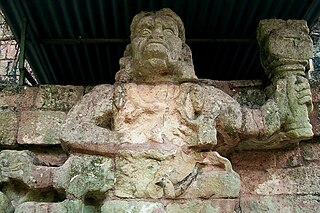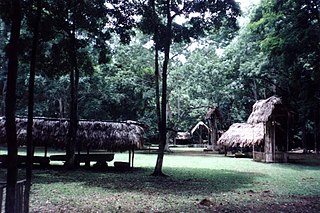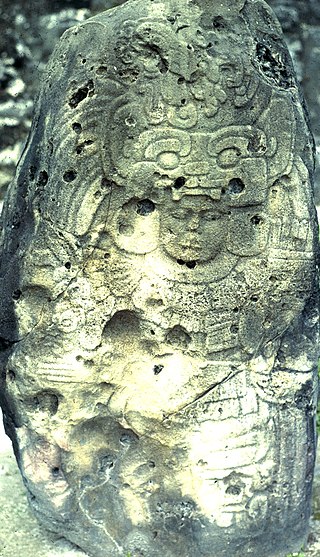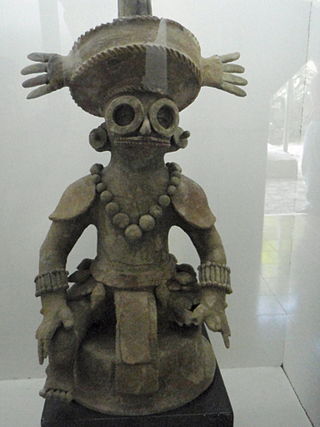
Copán is an archaeological site of the Maya civilization in the Copán Department of western Honduras, not far from the border with Guatemala. This ancient Maya city mirrors the beauty of the physical landscape in which it flourished—a fertile, well-watered mountain valley in western Honduras at an elevation of 600 meters above mean sea level. It was the capital city of a major Classic period kingdom from the 5th to 9th centuries AD. The city was in the extreme southeast of the Mesoamerican cultural region, on the frontier with the Isthmo-Colombian cultural region, and was almost surrounded by non-Maya peoples.

Dos Pilas is a Pre-Columbian site of the Maya civilization located in what is now the department of Petén, Guatemala. It dates to the Late Classic Period, and was founded by an offshoot of the dynasty of the great city of Tikal in AD 629 in order to control trade routes in the Petexbatún region, particularly the Pasión River. In AD 648 Dos Pilas broke away from Tikal and became a vassal state of Calakmul, although the first two kings of Dos Pilas continued to use the same emblem glyph that Tikal did. It was a predator state from the beginning, conquering Itzan, Arroyo de Piedra and Tamarindito. Dos Pilas and a nearby city, Aguateca, eventually became the twin capitals of a single ruling dynasty. The kingdom as a whole has been named as the Petexbatun Kingdom, after Lake Petexbatún, a body of water draining into the Pasión River.

Tikal is the ruin of an ancient city, which was likely to have been called Yax Mutal, found in a rainforest in Guatemala. It is one of the largest archeological sites and urban centers of the pre-Columbian Maya civilization. It is located in the archeological region of the Petén Basin in what is now northern Guatemala. Situated in the department of El Petén, the site is part of Guatemala's Tikal National Park and in 1979 it was declared a UNESCO World Heritage Site.

Quiriguá (Spanish pronunciation: [kiɾiˈɣwa]) is an ancient Maya archaeological site in the department of Izabal in south-eastern Guatemala. It is a medium-sized site covering approximately 3 square kilometres (1.2 sq mi) along the lower Motagua River, with the ceremonial center about 1 km (0.6 mi) from the north bank. During the Maya Classic Period (AD 200–900), Quiriguá was situated at the juncture of several important trade routes. The site was occupied by 200, construction on the acropolis had begun by about 550, and an explosion of grander construction started in the 8th century. All construction had halted by about 850, except for a brief period of reoccupation in the Early Postclassic (c. 900 – c. 1200). Quiriguá shares its architectural and sculptural styles with the nearby Classic Period city of Copán, with whose history it is closely entwined.

Yax Nuun Ahiin I, also known as Curl Snout and Curl Nose, was a 4th-century ruler of the Maya city of Tikal. His name when transcribed is YAX-?-AH:N, translated "First ? Crocodile". He took the throne on 12 September 379, and reigned until his death. He is referred to by the Mayan title ajaw, meaning lord.
"Spearthrower Owl" is the name commonly given to a Mesoamerican personage from the Early Classic period, who is identified in Maya inscriptions and iconography. Mayanist David Stuart has suggested that Spearthrower Owl was a ruler of Teotihuacan at the start of the height of its influence across Mesoamerica in the 4th and 5th century, and that he was responsible for an intense period of Teotihuacan presence in the Maya area, including the conquest of Tikal in 378 CE.
Siyaj Kʼakʼ, also known as Fire is Born, was a prominent political figure mentioned in the glyphs of Classic Period (250–800 CE) Maya civilization monuments, principally Tikal, as well as Uaxactun and the city of Copan. Epigraphers originally identified him by the nickname "Smoking Frog", a description of his name glyph, but later deciphered it as Siyaj Kʼakʼ, meaning "Fire is born". He is believed by some to have been the general of the Teotihuacano ruler Spearthrower Owl.

Calakmul is a Maya archaeological site in the Mexican state of Campeche, deep in the jungles of the greater Petén Basin region. It is 35 kilometres (22 mi) from the Guatemalan border. Calakmul was one of the largest and most powerful ancient cities ever uncovered in the Maya lowlands.

Kʼinich Yax Kʼukʼ Moʼ is named in Maya inscriptions as the founder and first ruler, kʼul ajaw, of the pre-Columbian Maya civilization polity centered at Copán, a major Maya site located in the southeastern Maya lowlands region in present-day Honduras. The motifs associated with his depiction on Copán monuments have a distinct resemblance to imagery associated with the height of the Classic-era center of Teotihuacan in the distant northern central Mexican region, and have been interpreted as intending to suggest his origins and association with that prestigious civilization. He is the founder of the Yax Kuk Mo Dynasty of rulers of Copan that lasted until 822 a.C. One of the most commonly cited motifs for this interpretation is the "goggle-eyed" headdress with which Yax Kʼukʼ Moʼ is commonly depicted; this is seemingly an allusion to the northern central Mexican rain deity known as Tlaloc by later peoples, such as the Aztecs. However, modern strontium isotope analysis of the human remains recovered from the tomb attributed to him indicate that Kʼinich Yax Kʼukʼ Moʼ spent his formative years much closer to Copán, at Tikal, and had not himself lived at Teotihuacan.

Uaxaclajuun Ubʼaah Kʼawiil, was the 13th ajaw or ruler of the powerful Maya polity associated with the site of Copán in modern Honduras. He ruled from January 2, 695, to May 3, 738.

Altar Q is the designation given to one of the most notable of the rectangular sculpted stone blocks recovered at the Mesoamerican archaeological site of Copán, present-day Honduras.

Maya kings were the centers of power for the Maya civilization. Each Maya city-state was controlled by a dynasty of kings. The position of king was usually inherited by the oldest son.
Yax Pasaj Chan Yopaat, also known as Yax Pasaj Chan Yoaat, Yax Pac and Yax Pasah, was ruler of the Maya kingdom of Xukpi from 763 to 810 or later. This is on the site of the city of Copán in western Honduras. He is the king who made Altar Q.

The known rulers of Tikal, a major centre of the Pre-Columbian Maya civilization in modern-day Guatemala:

The Margarita Tomb, also known as The Queens tomb, lies buried deep in the center of the Late Classic Acropolis of Copán, Honduras. It is a multi – leveled tomb with one of the largest caches ever found associated with the burial of a Maya woman.

Tikal Temple 33 was a 33-metre-high (108 ft) ancient Maya funerary pyramid located in the North Acropolis of the great Maya city of Tikal. The pyramid was centrally situated in the front row of structures facing onto the Great Plaza, between Temples 32 and 34 and in front of the Northern Platform. Temple 33 is one of the most thoroughly explored temples in the entire Maya area. The earliest version was a low funerary shrine over the tomb of king Siyaj Chan K'awiil II, which was sealed in AD 457. Temple 33 underwent three consecutive phases of construction, during which the king's funerary shrine was remodelled and one of his stelae was interred above his tomb. In the mid-1960s, archaeologists completely dismantled the final version of the large pyramid, uncovering the earlier phases of construction.

The North Acropolis of the ancient Maya city of Tikal in Guatemala is an architectural complex that served as a royal necropolis and was a centre for funerary activity for over 1300 years. The acropolis is located near the centre of the city and is one of the most studied of Maya architectural complexes. Excavations were carried out from 1957 to 1969 by the University of Pennsylvania, directed by Edwin M. Shook and William Coe.

Yax Ehb Xook, also known as Yax Moch Xok and Yax Chakte'I Xok, was the dynastic founder and ajaw of the Maya city-state of Tikal. He ruled c. 90 AD.
The Old royal family of Copán was the dynasty that ruled the city-state of Copan before the foundation of the Yax Kuk Mo dynasty in 426 AD. The ancient royal family of Copan has been under an aura of mystery due to the scant information we have about it, meaning that its existence is known thanks to archeological remains.

















